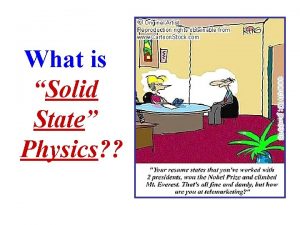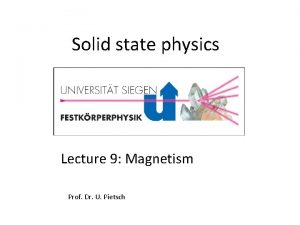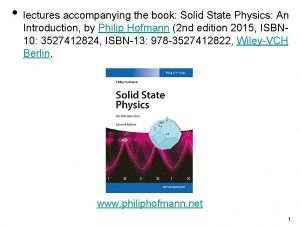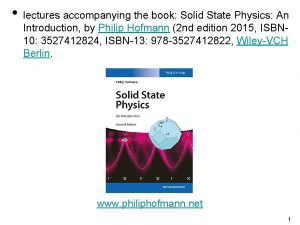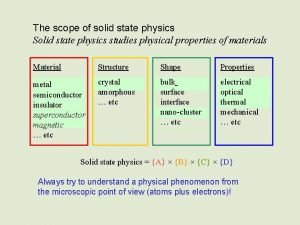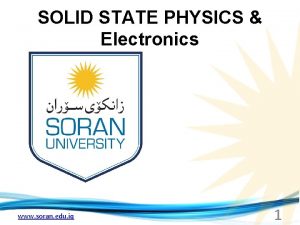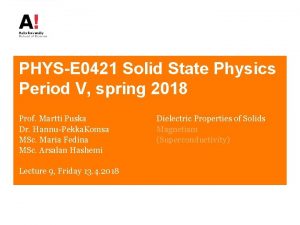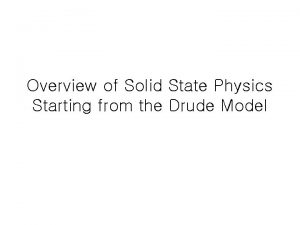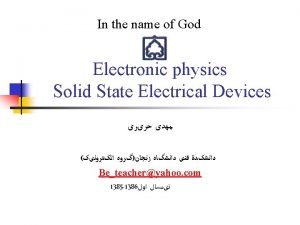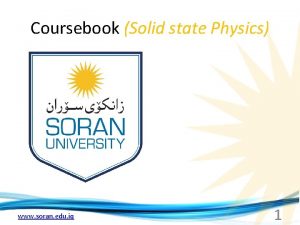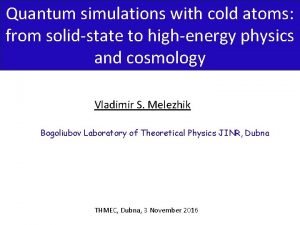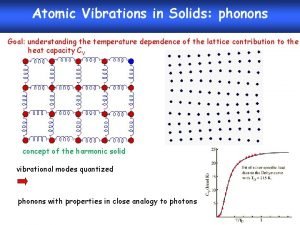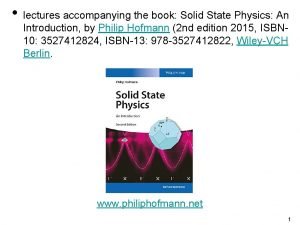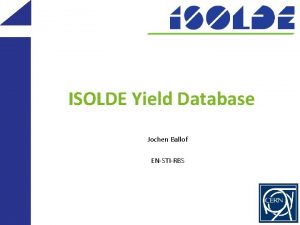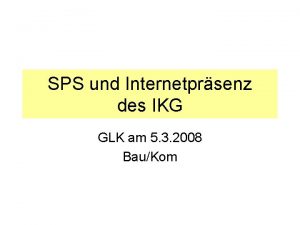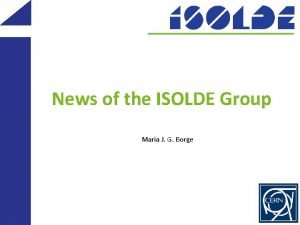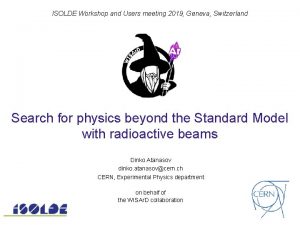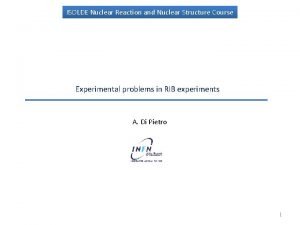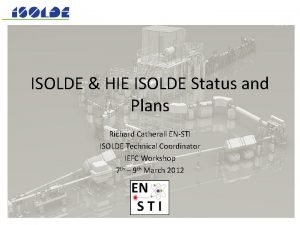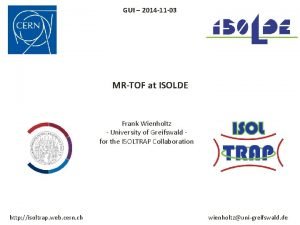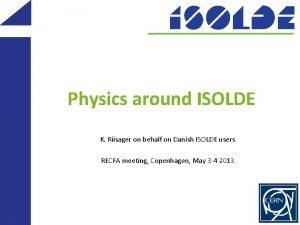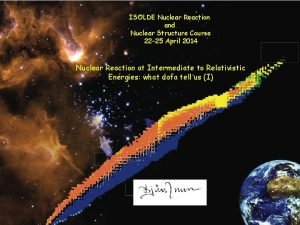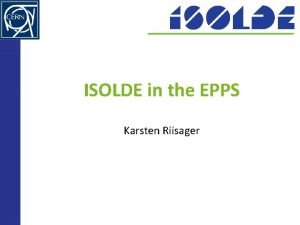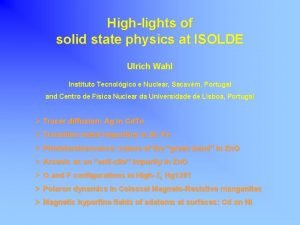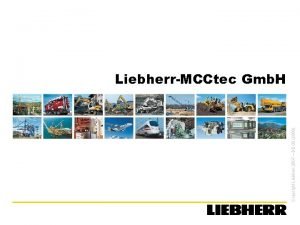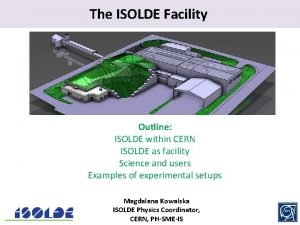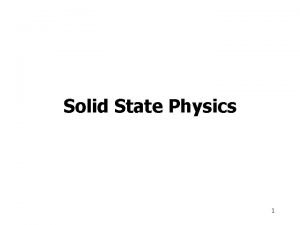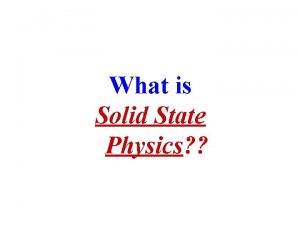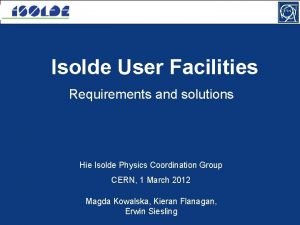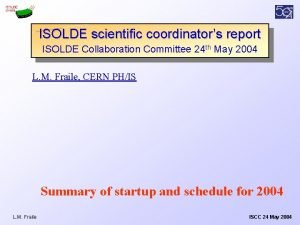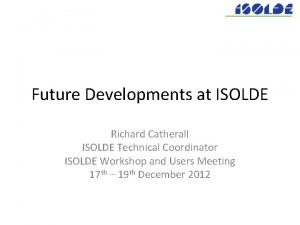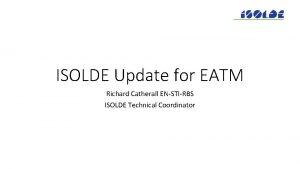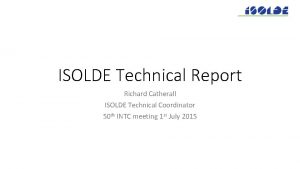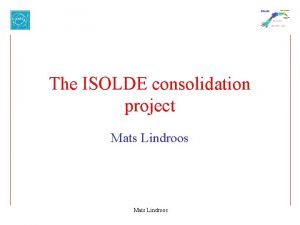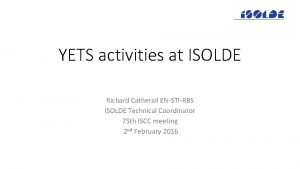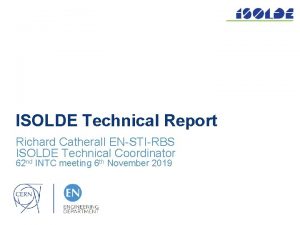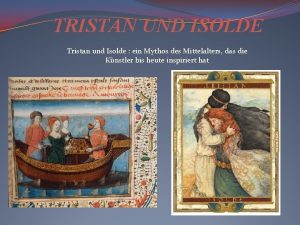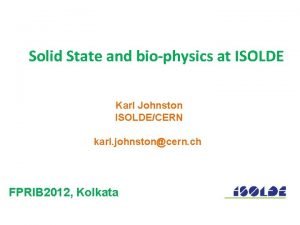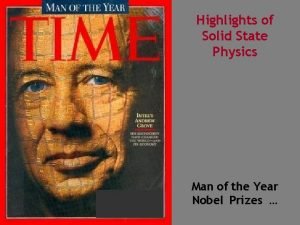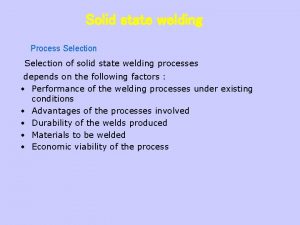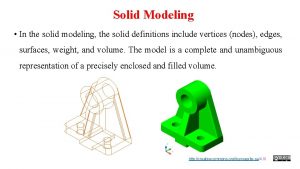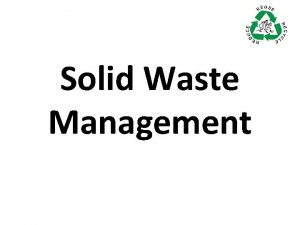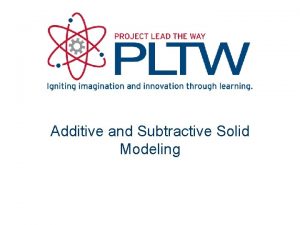Highlights of solid state physics at ISOLDE Ulrich


























- Slides: 26

High-lights of solid state physics at ISOLDE Ulrich Wahl Instituto Tecnológico e Nuclear, Sacavém, Portugal and Centro de Física Nuclear da Universidade de Lisboa, Portugal Ø Tracer diffusion: Ag in Cd. Te Ø Transition metal impurities in Si: Fe Ø Photoluminescence: nature of the “green band” in Zn. O Ø Arsenic as an “anti-site” impurity in Zn. O Ø O and F configurations in High-Tc Hg 1201 Ø Polaron dynamics in Colossal Magneto-Resistive manganites Ø Magnetic hyperfine fields of adatoms at surfaces: Cd on Ni

Use of radioactive isotopes in Solid State Physics - Detect nuclear radiation to quantify impurities: Þ radiotracer diffusion - Decay particles transmit information with atomic resolution: Þ Emission Channeling (EC) Þ Perturbed Angular Correlation (PAC) Þ Mössbauer Spectroscopy (MS) Þ Beta Nuclear Magnetic Resonance (b-NMR) - Identify spectroscopic signals via isotope half life: Þ Photoluminescence (PL) Þ Deep Level Transient Spectroscopy (DLTS Þ Hall effect At ISOLDE often several of these methods are used in combination

The “unusual” diffusion of 111 Ag in Cd. Te “Normal” Gaussian diffusion profile Very unusual symmetrical diffusion profile Why? H. Wolf et al, Phys. Rev. Lett 94 (2005) 125901

Lattice location of 107 Cd 107 m. Ag(40 s) and 109 Cd 109 m. Ag(44 s) in Cd. Te Emission Channeling lattice location: Ø substitutional Ag. Cd Ø low stability of Ag. Cd Ea = 0. 92(4)e. V Ø long-range diffusion Ø amount of Ag. Cd depends on the Cd stoichiometry Cd Te Ag Agi + VCd Û Ag. Cd Agi + Cd. S Û Ag. Cd + Cdi S. G. Jahn et al, J. Cryst. Growth 161 (1996) 172

Diffusion of 111 Ag in Cd. Te depletion of Ag in surface regions due to slow indiffusion of Cd [Ag. S] ~ [VCd] Cd Cd Symmetrical diffusion profile Cd Te Ag Agi + VCd Û Ag. Cd Agi + Cd. S Û Ag. Cd + Cdi + VCd Û Cd. S H. Wolf et al, Phys. Rev. Lett 94 (2005) 125901

International Technology Roadmap for Semiconductors Identify + control Fe in Si below 1010 cm-3

Transition metal impurities in Si Ø Fe, Ni, Co, Cu… fast interstitial diffusers Ø deep centers Ø interact with dopants and change the electrical properties of dopants Ø must be gettered away from active region of devices, e. g. by trapping at radiation damage Þ investigate properties of Fe in Si by Emission Channeling (EC) and Mössbauer spectroscopy (MS)

Lattice site changes of implanted 59 Fe in Si experiment simulations b- angular emission channeling patterns RT as-implanted: annealed at T=300°C: annealed at T=800°C: mainly displaced substitutional Fe mainly tetrahedral interstitial Fe mainly ideal substitutional Fe Ø At least 3 different Fe lattice sites Ø Following release to interstitial state re-gettering occurs at a different gettering center on ideal substitutional sites U. Wahl et al, Phys. Rev. B 72 (2005) 014115

Mössbauer effect from 57 Mn 57 Fe in Si Fei. V Ø MS line broadening reveals difference in diffusion coefficients of Fei+ and Fei 0 Ø 4 -5 different Fe centers identified Øinterstitial Fe seen by EC is probably a (Fei-V) complex Fei. V H. P. Gunnlaugsson et al, Appl. Phys. Lett. 80 (2002) 2657

Zinc Oxide Ø wurtzite semiconductor with band gap of 3. 4 e. V Ø very similar to Ga. N but with superior optical properties Ø large single crystals available Nichia Co. , Japan Ga. N blue laser Why not yet in Zn. O? Major problem Ø all undoped crystals are n-type (vacancies, interstitials, other defects, impurities? ) Ø p-doping extremely difficult

Puzzles of the “green band” in Zn. O “Structured” green luminescence band in Zn. O R. Dingle, Phys. Rev. Lett. 23 (1969) 579 Conflicting explanations for the “green band” in the literature: • Cu. Zn - impurities • Vacancies (e. g. , VO, VZn) Þ investigate properties of Cu in Zn. O and nature of green band by emission channeling and PL

Lattice location of 67 Cu 67 Zn in Zn. O Experiment Simulation for Cu. Zn 61. 9 h 67 Cu b- ISOLDE / CERN: • 2´ 1013 cm-2 at 60 ke. V • 200°C, 10 min, vacuum 67 Zn Implanted Cu occupies substitutional Zn sites: Cu. Zn ü U. Wahl et al, Phys. Rev. B 69 (2004) 012102

PL-Signals of 64 Cu (64 Ni, 64 Zn) in Zn. O b 39% 64 Zn 64 Ni Intensity [a. u. ] EC 61% 64 Cu Intensity [a. u. ] 12. 7 h t 1/2 = 12. 1(1) h Time t [h] 72 h 12 h 3 h Zn. O: Green band Literature - Cu. Zn - impurities - Vacancies - Ni - impurities ? Green band Energy [e. V] ISOLDE / CERN: • 5´ 1012 cm-2 at 60 ke. V • 800°C, 30 min, O 2 T. Agne et al, submitted to Phys. Rev. Lett.

PL-Signals of 65 Ni 65 Cu in Zn. O b- 65 Cu Intensity [a. u. ] 65 Ni Intensity [a. u. ] 2. 52 h t 1/2 = 2. 6(2) h 12 h Time t [h] 3, 6 h 1, 0 h Zn. O: Green band Literature - Cu - impurities - Vacancies - Ni - impurities ? Green band Energy [e. V] ISOLDE / CERN: • 5´ 1012 cm-2 at 60 ke. V • 800°C, 30 min, O 2 T. Agne et al, submitted to Phys. Rev. Lett.

Recoil energies of 64 Cu and 65 Ni 2. 52 h 12. 7 h EC 61% 64 Cu b 39% 65 Ni b- 64 Zn 65 Cu 64 Ni Recoil energy: b- - decay Erecoil » 37. 7 - 55. 7 e. V EC - decay Erecoil = 23. 5 e. V Displacement energy in Zn. O *: Zn-atoms Edispl = 19 e. V O-atoms Edispl = 41 - 57 e. V * D. C. Look, J. W. Hemsky, Phys. Rev. Lett. 82, 2552 (1999) Both decays produce Zn vacancies: Green band « Zn vacancies in Zn. O T. Agne et al, submitted to Phys. Rev. Lett.

The difficulties in p-type doping of Zn. O Candidates for acceptors: N, P, As, Sb Group V on SO Li, Na, K, Rb Group Ia on SZn Cu, Ag Group Ib on SZn already studied at ISOLDE investigations foreseen Example: Is As a suitable acceptor in Zn. O? Maybe, but it does not like to occupy O sites but prefers Zn sites!

73 As as an “anti-site” impurity in Zn. O Only patterns for SZn fit the experimental results! U. Wahl et al, in print, Phys. Rev. Lett. (2005)

High-Tc superconductors Ø Superconductivity and its Tc critically influenced by the charge that O 2 - doping introduces in the superconducting Cu. O 2 planes Ra di oa ct i ve PAC io ns Ø Twice the number of F- introduce the same charge doping Þ investigate atomistic configurations of O 2 - and Fdopants by means of electrical field gradient (EFG) it causes on PAC probe atom 199 m. Hg Electric Field Gradient dopant configuration fingerprint

Oxygen & Fluorine Configurations in Hg 1201 (High-Tc) h ~ 0. 20 Experiment Ø In contrast to O, F orders in small atomistic stripes Ø Local deformations and atomistic stripes in the doping planes are NOT responsible for charge ordering at the Cu. O 2 planes EFG Simulations 100 C A P 50 0 0 2500 w(Mrad/s) 5000 h ~ 0. 0 100 PA C 50 Hg. Ba 2 Cu. O 4+d Tc > 92 K 0 0 2500 5000 w(Mrad/s) J. G. Correia et al, in press, Phys. Rev. B (2005)

Colossal Magnetoresistive Manganites Strong coupling of spin, charge, orbital and lattice degrees of freedom Complex multi-scale world with: Intrinsic inhomogeneities Clusters and stripes (charge, spin and structure) Unconventional phase transitions Charge-coupled lattice deformations: Polarons Þ use 111 m. Cd impurities as local observers of the nature of structural phase transitions by means of PAC

Unconventional phase transitions as seen by 111 m. Cd in La. Mn. O 3. 12 EFG asymmetry parameter h Two main local 111 m. Cd. La environments EFG u Undistorted EFG d fraction [%] Strong Jahn-Teller Distortion Free Percolation critical exponent b =0. 42(2) 111 m. Cd threshold: 31% Temperature [K] A. M. L. Lopes et al, submitted to Phys. Rev. Lett.

111 m. Cd in La. Mn. O 3. 12 : polaron dynamics Dynamic Jahn-Teller distortions related to polaron diffusion give rise to EFG fluctuations/attenuation Fast fluctuations regime (observable region) Ea~0. 31 e. V • Thermally activated polaron dynamics • Hopping energy Ea~0. 31 e. V A. M. L. Lopes et al, submitted to Phys. Rev. Lett.

Magnetism on surfaces Different adatom sites can be prepared via deposition and anneal temperature Þ allows systematic studies of magnetic hyperfine fields BHF at different sites by means of PAC

BHF parabolic function of coordination number K. Potzger et al, Phys. Rev. Lett. 88 (2002) 247201

Solid state physics at ISOLDE covers a wide range of materials: Ø Semiconductors: Si, Ge, Si. Ge, diamond, III-V, nitrides, II-VI, Zn. O… electrical doping, transition metals, rare earths, H, diluted magnetic semiconductors Ø High-Tc superconductors and perovskites Ø Magnetism (manganites, CMR) Ø Low dimensional systems: surfaces, interfaces, multilayers ISOLDE’s strength: the variety of different experimental methods that can be combined to study these materials

Thanks to Thomas Agne, U Leipzig Vitor Amaral, U Aveiro João Pedro Araújo, U Porto Joachim Bollmann, U Dresden João Guilherme Correia, ITN Lisbon + CERN Manfred Deicher, U Saarbrücken Haraldur Gunnlaugsson, U Aarhus Karl Johnston, U Saarbrücken + CERN Yuri Manzhur, HMI Berlin Bart De Vries, IKS Leuven Gerd Weyer, U Aarhus Herbert Wolf, U Saarbrücken Wolf-Dietrich Zeitz, HMI Berlin for providing slides
 Solid physics
Solid physics Magnetism
Magnetism Philip hofmann solid state physics
Philip hofmann solid state physics Philip hofmann solid state physics
Philip hofmann solid state physics Scope of solid state physics
Scope of solid state physics Crystalline solid
Crystalline solid Solid state physics
Solid state physics Solid state physics
Solid state physics Drude model solid state physics
Drude model solid state physics Quantum number l meaning
Quantum number l meaning Solid
Solid Simulations for solid state physics
Simulations for solid state physics Understanding solid state physics
Understanding solid state physics Philip hofmann solid state physics
Philip hofmann solid state physics Isolde yield database
Isolde yield database Ikg rt
Ikg rt Maria jg
Maria jg Isolde workshop
Isolde workshop Reaction structure
Reaction structure Isolde
Isolde Isolde frank
Isolde frank Isolde k
Isolde k Phys. rev. c
Phys. rev. c @isolde
@isolde Isolde reveal
Isolde reveal Isolde liebherr
Isolde liebherr Key highlight
Key highlight
